From the Trevi Fountain to the Colosseum, the Spanish Steps to the Vatican, we’ve put together the top 15 things to see in Rome along with some handy Rome travel tips including how to get to Rome from the airport(s!), how to get around, what to eat, where to stay and even some day trips for those with a spare day or two.
Packed with history, amazing architecture, museums, churches, and religious relics of days gone by (not to mention another city within the city!), Rome is a wonderful place to explore for a few days. Spend your time taking in the sights, fuelled by fresh, delicious Italian food, and rounding out each day with a Limoncello or glass of delightful Italian wine. If that doesn’t sound like travel heaven, I don’t know what does!
Scroll down and get planning your trip to Rome Italy.

Disclaimer: Almost all posts on this site contain Affiliate links, and this one about 15+ BEST Things to see in Rome Italy (Perfect for first-time visitors) is no different. This means that if you click on any of the links in this post (and make a purchase) I may receive a small commission at absolutely no cost to you. Each post is carefully crafted to (hopefully!) answer all your questions and recommendations are made where we believe they will improve your trip and help with your planning. As such we thank you in advance should you decide to click & buy. Read my full Disclosure here.
Contributed by Chrysoula from TravelPassionate.com
In This Post
- 1 Essential Rome Travel Tips: What to Know Before you Go
- 2 15+ Beautiful Things to See in Rome
- 2.1 Colosseum
- 2.2 Roman Forum and Palatine Hill
- 2.3 St Peter’s Basilica
- 2.4 Vatican Museums
- 2.5 Piazza Navona
- 2.6 Fontana di Trevi
- 2.7 Pantheon
- 2.8 Spanish Steps and Piazza di Spagna
- 2.9 Villa Borghese
- 2.10 Capitoline Museums
- 2.11 Piazza del Popolo
- 2.12 Go Church Hopping
- 2.13 Castel Sant’Angelo
- 2.14 Victor Emmanuel II Monument
- 3 Day Trips from Rome
Essential Rome Travel Tips: What to Know Before you Go
A Little Bit of Rome History
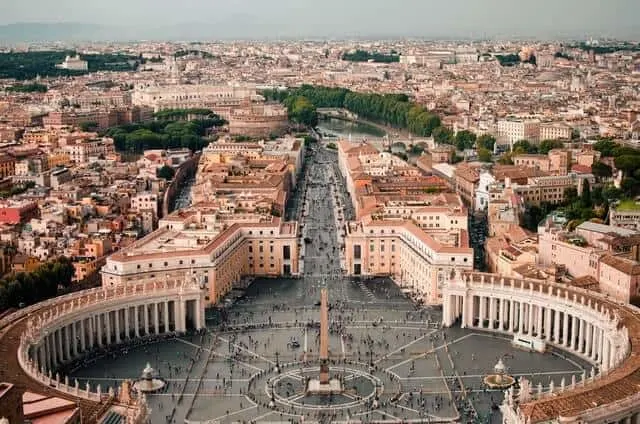
Rome, Italy is a city that transcends time. Known as the Eternal City, Rome’s history stretches from its mythical founding to the center of an ancient empire to a modern global city. Rome was founded in 753 BCE, as the pastoral settlements on the Palatine and Capitoline Hills grew into something much larger, though settlement itself dates back much longer than that. Legend says that the wolf-twins Romulus and Remus founded the city before Romulus killed his brother, though the archaeological evidence supports a more organic growth.
Rome grew as a monarchical system for several hundred years before establishing an oligarchic republic. In the early 1st century CE (AD), under Octavian, the Roman Republic transitioned to the Roman Empire. Over the centuries, the city was the center of the ancient world, ruled by the Byzantines, the Franks, and the Lombards after the fall of the Roman Empire in 476 CE, and went from a city of one million to a city of 100,000 over just 200 years.
Not only is Rome the capital of Italy and the former capital of the Empire, but it’s also been the seat of the Roman Catholic Church for hundreds of years. Vatican City is the only country in the world to sit within another city’s boundaries, and Rome has been called the capital of two countries for that reason.
There are so many interesting things to see and do in Rome, from exploring ancient history to experiencing the modern Italian city. Below are some of my favorite places to include in your Rome itinerary.
How to get from the Airport to Rome
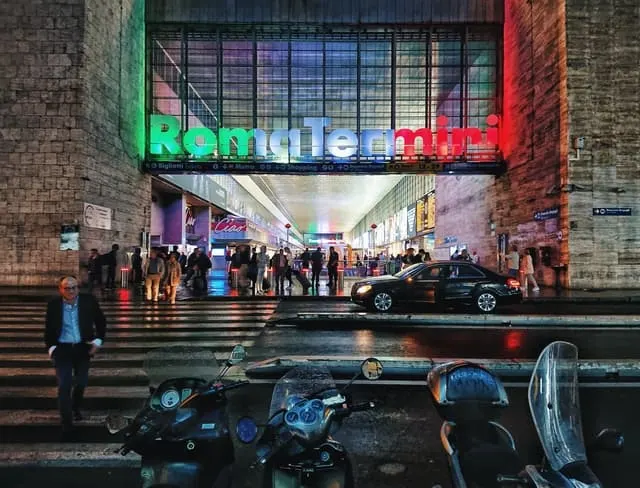
Rome has two airports – Fiumicino Leonardo Da Vinci Airport, and Ciampino G. B. Pastine Airport – and it is important to know which one you will be arriving at or departing from!
Ciampino Airport is actually much closer to the city center of Rome than Fiumicino, and is where most flights from Ryanair & Wizz Air land and depart from. The best way to get to and from the city center is via taxi (approx €30-40) or public bus which is relatively inexpensive (€6-8) and will take 40-60 minutes.
Fiumicino is the main airport. It is 32km from Rome city center and accommodates larger, full-service airlines.
There are several ways to get from Fiumicino Airport to Rome city center, which include minivan shuttle (approx €19), transfer bus (approx €6), taxis (approx (approx €50), private transfer, train and public bus. Depending on which method you choose, the journey will take between 60 and 90 minutes.
Getting Around Rome
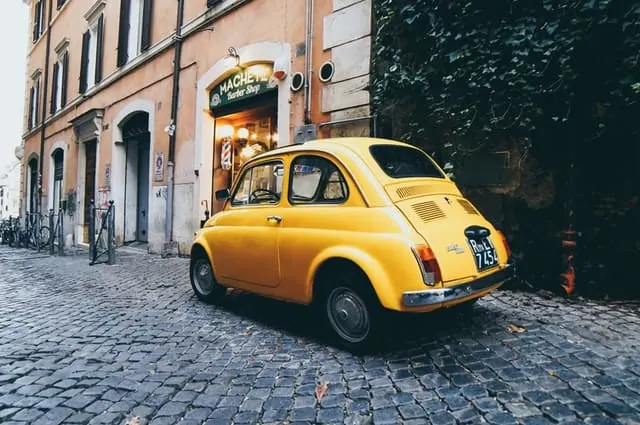
Rome is really easy to get around. There is a very easy metro system with stations near the Vatican and the Colosseum as well as in some of the city’s main squares. However, one of the best ways to see Rome is to walk. Rome is one of those cities where you turn the corner, and there is something ancient in front of you. The surprises never end, and by walking the streets of Rome, you will see many of Rome’s secrets. Or if you are short on time and want to see the highlights we recommend joining a custom tour.
The Eternal City is a city whose history lies visible to all. The Roman Forum and the Colosseum tell us about the Romans of old, and we’ve learned a lot from the archaeological findings there. The Vatican and her museums share with us the wealth and power of the Church. And the public piazzas and gardens indicate how beloved Rome has been for her citizens and patrons over the centuries. A trip to Rome takes you down memory lane, and a walk through town will introduce you to the delights of Italian culture.
What to Eat in Rome (and Where)

Italians are famous for their food, and Romans have their own spin on a lot of dishes. Some of the best things to eat in the city are cacio e pepe – cheese and pepper pasta – trippa (offal), carbonara, saltimbocca, and pizza alla romana. Head for the Monti and Prati neighborhoods for local eateries or join a street food tour with a local guide and enjoy tastings at some of the best spots in the city.
If you find yourself near the Pantheon, Piazza Navona, or Piazza di Spagna, don’t try to find a place to eat in those areas. For a more authentic experience (and better food), you’re likely to find a more local place if you go a few blocks away from the tourist attraction. (And if you find a dining establishment empty at the local dinner time, skip it in favour of one that’s busy with locals.)
RELATED: Want to learn to cook authentic Italian dishes at home? Join an Italian Cooking Class with Gourmet Lunch and learn while you eat!
Where to Stay in Rome
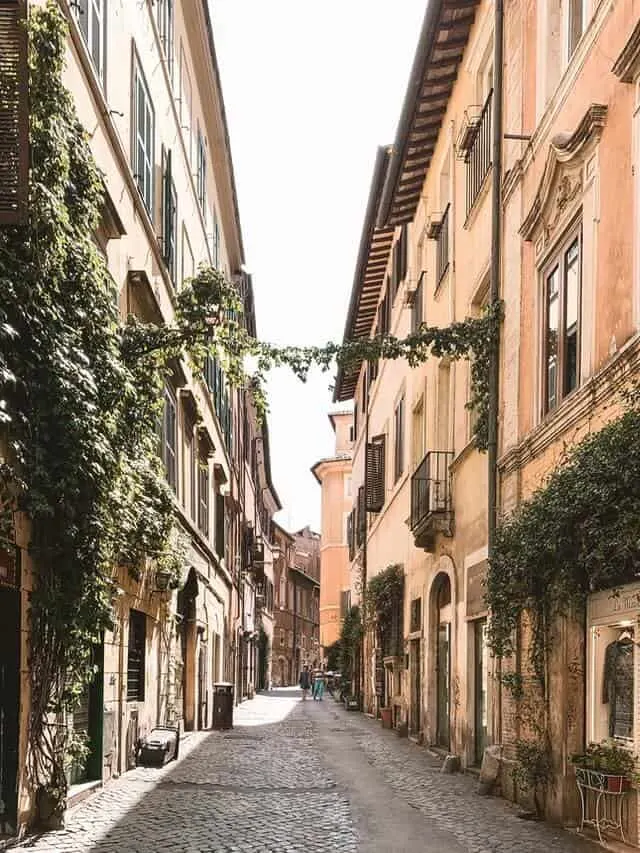
Picking a hotel in Rome may seem like a daunting task, but we are here to help and can help you narrow it down by budget and location depending on what you are looking for.
- Luxury (5*): The Pantheon Iconic Rome Hotel: A luxury hotel in Romes historic center, complete with a rooftop terrace for nightcap views across the city.
- Mid-Range (3*): Hotel Santa Maria: A 3* hotel in Rome’s trendiest neighborhood – Trastevere, on the banks of the Tiber River.
- Budget (2*): Boutique Hotel Atelier ‘800: 600 m from Navona Square with the lively nightlife of Campo de’ Fiori square is a 10-minute walk away.
15+ Beautiful Things to See in Rome
Colosseum
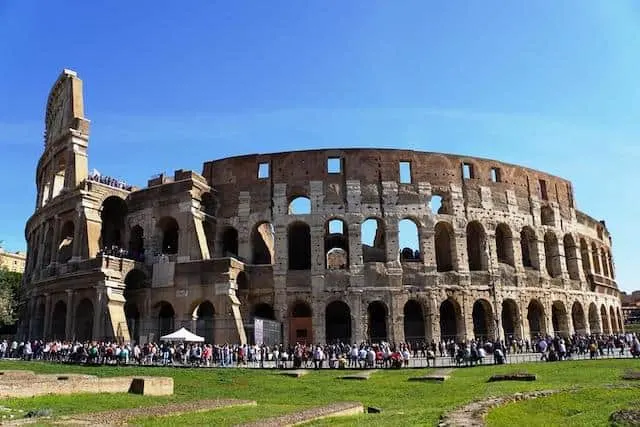
The Colosseum is undoubtedly one of the most iconic sights in Rome. A gigantic concrete amphitheater surrounding the ruins of a gladiator fighting ring built by the ancient Romans, it’s exterior is one of the most impressive views of Rome. The Colosseum was built from travertine limestone and concrete (a Roman invention) and the Colosseum was used for staged sea battles, animal hunts, executions, and mythological dramas.
In Christianity, the Colosseum is considered a site of martyrdom during the persecution of Christians, while in modern history it is where Pope Benedict XVI led the Stations of the Cross on Good Friday. It could hold up to 80,000 people at any given time and had an elaborate set of mechanisms in order to support its various activities.
The exterior is made up of several walls; the outside one is made of arcades highlighting the Classical orders. Doric, the earliest Classical order, is the lowest column, while the Ionic and Corinthian are higher. As one of the top attractions in Rome, tickets for the Colosseum regularly sell out and so our top tip when visiting Rome is to consider purchasing tickets online prior to arrival or booking a tour that can pre-purchase skip the line tickets.
Rome is also a great place to visit in Italy with kids, and there are dedicated tours for families to help keep kids engaged on the tour.
Roman Forum and Palatine Hill
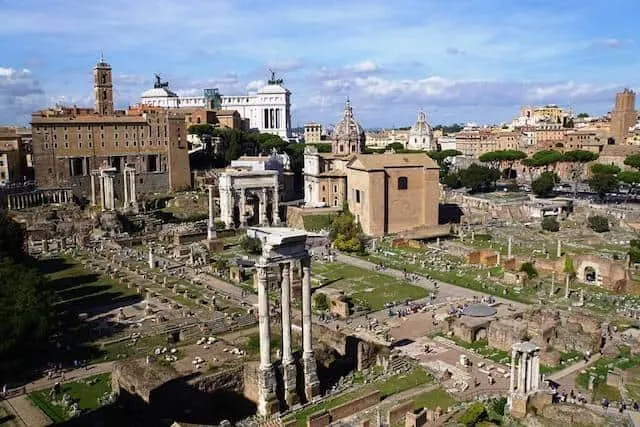
Across from the Colosseum is the Roman Forum, a vast area of land between the Capitoline and Velian hills that has some of Rome’s earliest temples, senate houses, and baths. Legend and archaeology say that early Rome was built on the Palatine Hill.
The Palatine Hill stands 40m above the Forum and the Circus Maximus, home to many Imperial Palaces and the Domus Augustana. For centuries the Roman Forum was the center of everyday life in Rome. Public speeches and trials, processions, and commercial affairs all would have taken place here.
The last significant additions were made in the early 4th century CE, but in the 6th century, some buildings were transformed into Christian churches. Many of the buildings were taken apart or rearranged and their stones used in other buildings, including the new Saint Peter’s Basilica in the 1500s.
St Peter’s Basilica
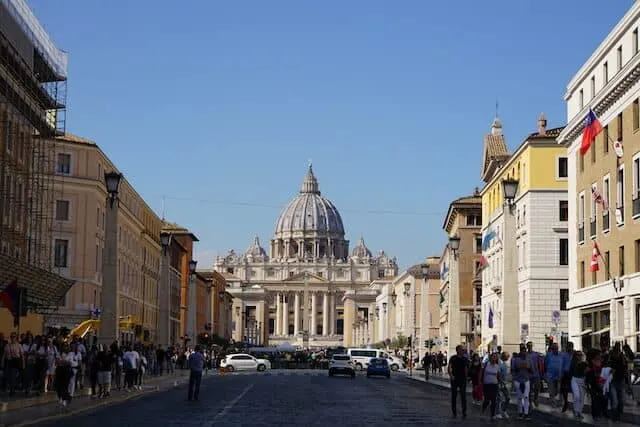
The heart of Vatican City is St. Peter’s Basilica, located a few miles from the Roman Forum and Colosseum. Contrary to popular belief, St. Peter’s is not the mother church of the Catholic religion, though it is the most famous. St. Peter’s is the world’s largest Church and also the most renowned and recognisable work of Renaissance architecture.
The Church is fronted by St. Peter’s Square, which is lined with elegant colonnades. The interior is lavishly decorated with sculptures, gilding, marble reliefs, and more. One of the most famous sculptures inside St. Peter’s is Michelangelo’s Pieta. Catholic history says that St. Peter, the first Bishop of Rome is buried under the high altar, and for this reason, many other popes are buried here.
In addition to visiting the Church’s interior, visitors can also climb the Basilica dome to the roof and look out over the piazza.
Vatican Museums
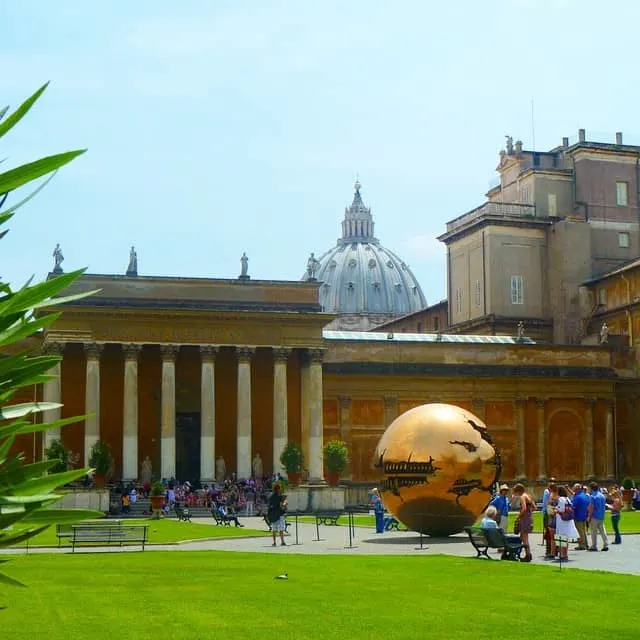
Adjacent to the Basilica are the Vatican Museums. These 54 galleries house everything from vast libraries to the Hall of Maps and the Sistine Chapel. The museum was founded in the early 16th century by Pope Julius II and has over 70,000 works of Renaissance art, Roman sculpture, and modern religious art – it’s no wonder it’s one of the most incredible museums in Rome.
Some of the most important and well-known works in the museum include Bellini’s Pieta, Raphael’s The Crowning of the Virgin, and Titian’s Portrait of Doge Marcello. The Sistine Chapel is the last official stop in the Vatican Museums; it is famous for its frescoed ceiling and is one of the world’s most impressive works of art.
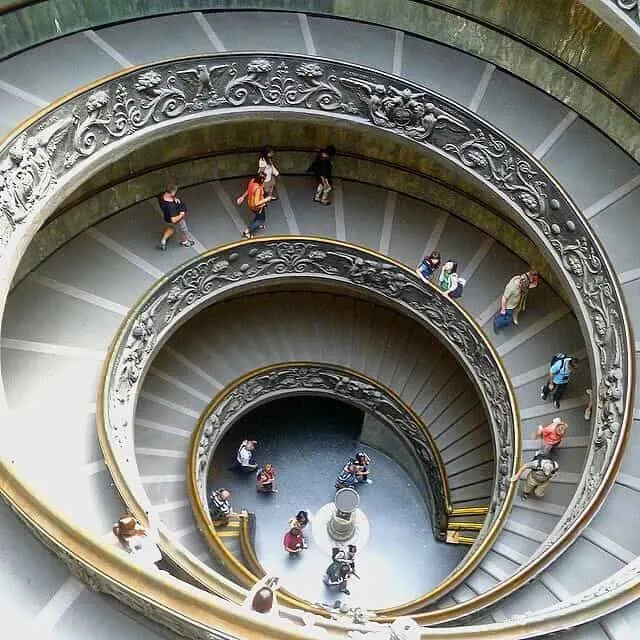
And for a grand exit, be sure to take the helix Bramante Staircase back down to ground level. It really is one of the best things to see in Rome – and so many people miss it!
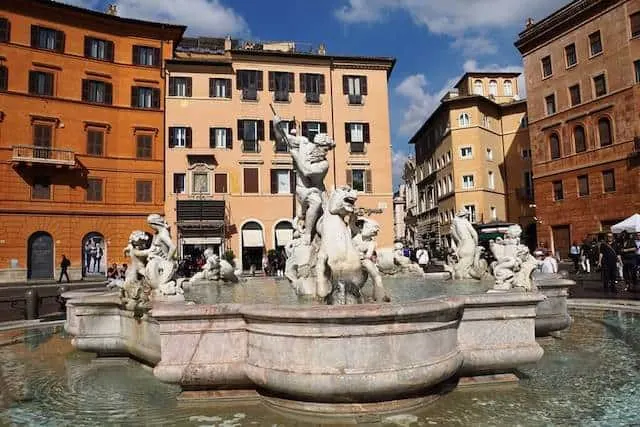
Piazza Navona is a public square in the heart of Rome, on the site of the 1st-century Stadium of Domitian. It is an elegant and important example of Baroque Roman architecture and has several former palaces facing the piazza. There are also three major Rome fountains in the piazza: the Fontana dei Quattro Fiumi at the centre of the elongated square, the Fontana del Moro and the southern end and the Fontana di Neptune at the northern end. Piazza Navona was featured in Angels and Demons.
Fontana di Trevi
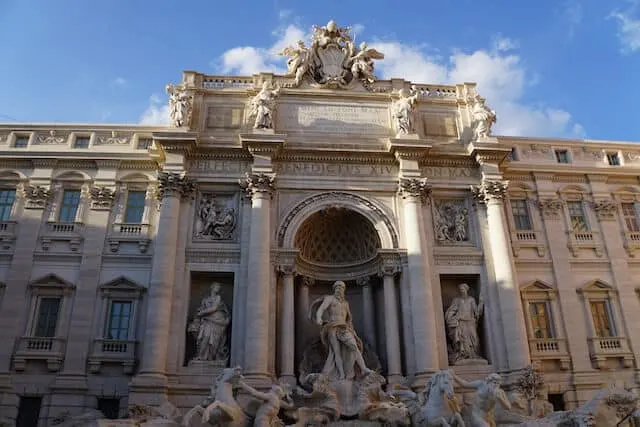
The Fontana di Trevi, or Trevi Fountain, is the largest Baroque fountain in the city, and one of the most famous fountains in the world. It is located at the intersection of three ancient roads (tre vie) and is one of the top sights in the city. The fountain sits on the site of an earlier fountain and was constructed in the 1700s. There are a number of sculptures and icons on the fountain, including Oceanus, Tritons, Abundance, and Salubrity.
It is said that if you throw a coin over your left shoulder using your right hand, you will return to Rome. It’s estimated that over €1.5 million are thrown in yearly, and the money is used to fund a supermarket for the homeless.
Pantheon
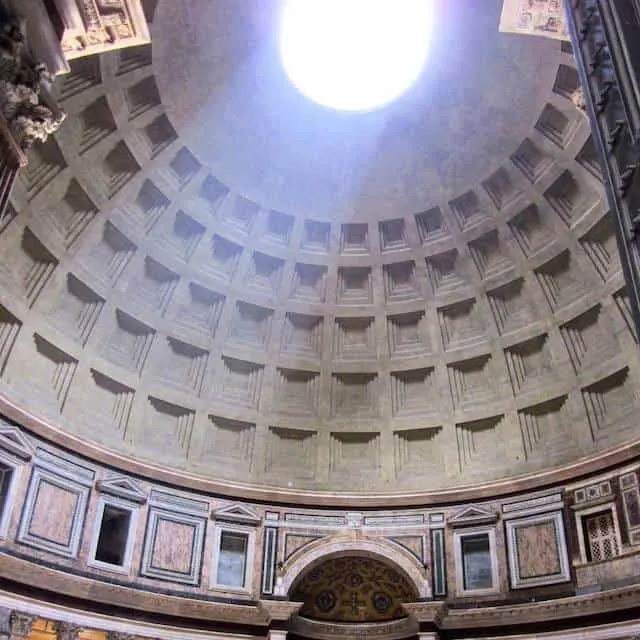
The Pantheon is a former Roman temple turned Roman Catholic church on the site of an earlier temple. It was built by the emperor Hadrian, and the inscription on the frieze is from the original temple, so the date of completion is uncertain. The Pantheon has been in continuous use since its construction, and it, therefore, is one of the best-preserved ancient buildings.
The open oculus lets in light and rain, and the concrete dome is still the world’s largest unreinforced concrete dome. Its interior features high altars and apses with sculptures. There are also several tombs in the building; the most famous of these is Raphael. Up until recently, the Pantheon was free to enter, although in 2018 they instituted a €2 entry fee.
Spanish Steps and Piazza di Spagna
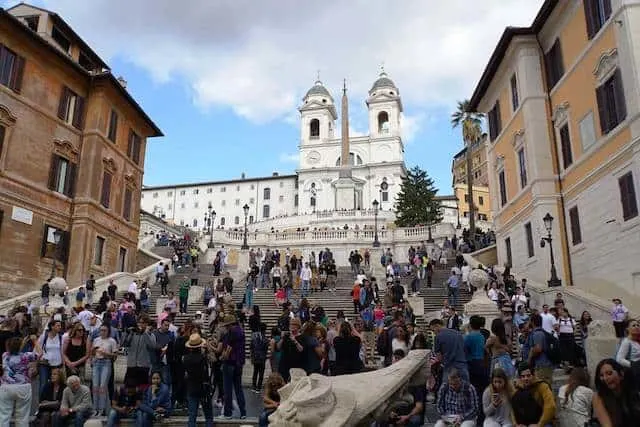 Piazza di Spagna is at the bottom of the Spanish Steps and is one of the most famous piazzas in Rome. The nearby Embassy of Spain to the Holy See gives its name to this area. The former house of English poet John Keats is to the right of the staircase and is now a museum dedicated to English Romantic writers.
Piazza di Spagna is at the bottom of the Spanish Steps and is one of the most famous piazzas in Rome. The nearby Embassy of Spain to the Holy See gives its name to this area. The former house of English poet John Keats is to the right of the staircase and is now a museum dedicated to English Romantic writers.
The 135-step staircase rises from the piazza to the Trinita dei Monti church at the top. It was designed by architects Francesco de Sanctis and Alessandro Specchi. While the piazza and the staircase are often crowded, it is forbidden to sit or eat on the steps, so traffic moves fairly quickly.
Villa Borghese
The Villa Borghese and the Borghese Gardens are located on the Pincian Hill, just above the Spanish Steps and Piazza di Spagna. Villa Borghese was built in the early 17th century by Cardinal Scipione Borghese, who wanted to turn his vineyard into the most extensive gardens in Rome. Today the Borghese Gardens are the third largest public park in the city and are completely open and free to the public.
The Villa Borghese is home to the Galleria Borghese (Borghese Gallery), which has some of the most impressive collections of Renaissance work outside of the Vatican Museums. The main floor is dedicated to classical antiquities and neo-classical sculpture. Borghese was a patron of Bernini, and so visitors will also find a wide range of both his painting and his sculptures.
Capitoline Museums
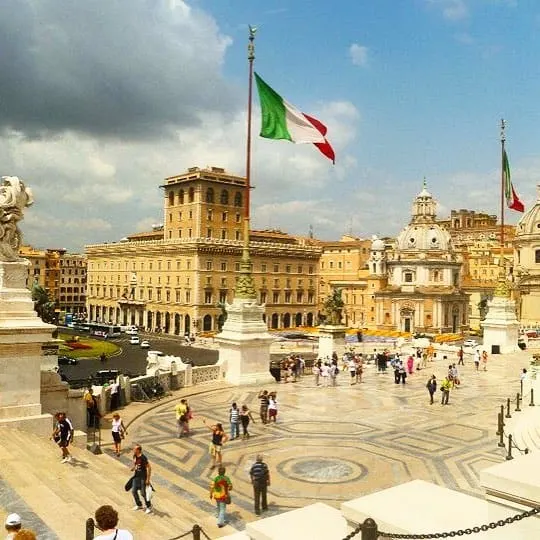
The Capitoline Museums is a single museum on top of Capitoline Hill. Opened in 1734 by Clement XII, the museum actually dates back to 1471, when Pope Sixtus IV donated a collection of bronzes to the people of Rome. The collection has since expanded to include ancient statues, medieval and Renaissance art, jewels, coins, and more.
Piazza del Popolo
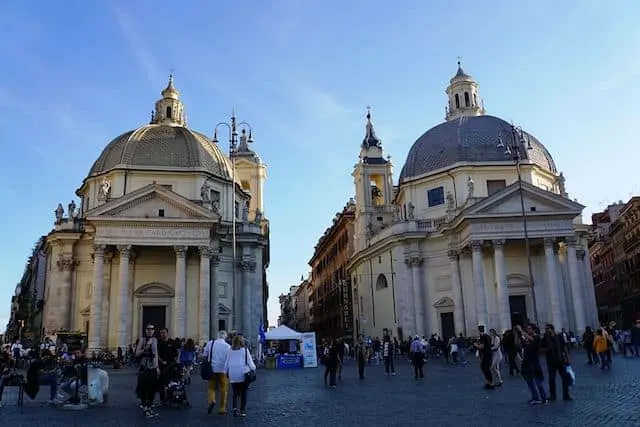
On the other side of the Spanish Steps from the Villa Borghese is the Piazza del Popolo, located just inside of the northern gate of the Aurelian Walls of the city. Highlights in the piazza include the Egyptian obelisk of Ramesses II, the twin churches of Santa Maria dei Miracoli and Santa Maria in Montesanto, and the main Church, Santa Maria del Popolo.
Go Church Hopping
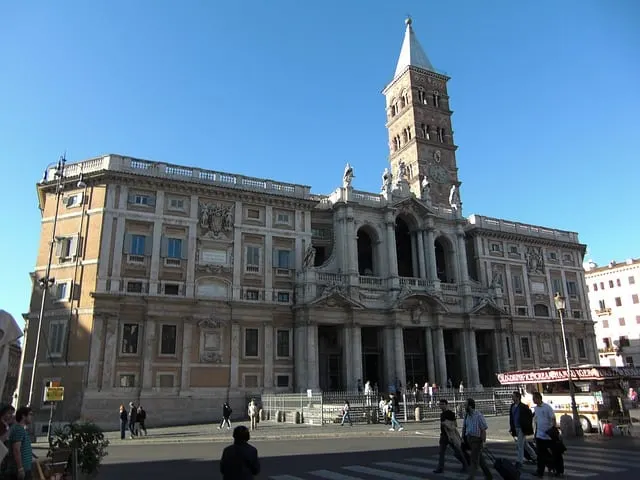
Visiting the churches in Rome, were for many centuries, the goal of the majority of Rome’s pilgrim visitors. Today’s tourists still include pilgrims, but far more visit Rome’s churches as attractions, to admire their architecture and the art treasures they hold. In them, you’ll find works by some of the greatest masters including Michelangelo, Raphael, Bernini, Caravaggio, and Sansovino.
To follow in the footprints of the pilgrims be sure to visit the seven sites that were designated as pilgrimage churches: The four patriarchal basilicas (San Giovanni in Laterano, San Pietro in Vaticano, San Paolo Fuori le Mura, and Basilica di Santa Maria Maggiore), as well as three other churches: Santa Croce in Gerusalemme, San Lorenzo Fuori le Mura, and San Sebastiano.
Castel Sant’Angelo
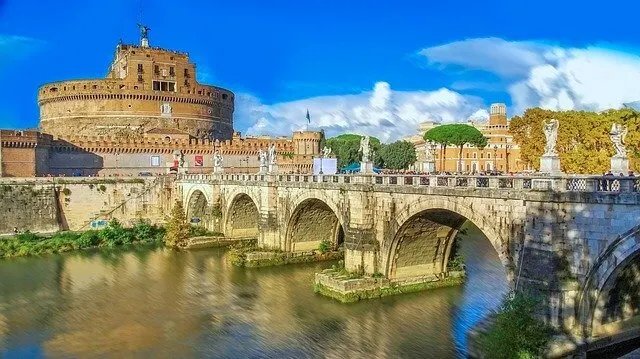
Hadrian’s Tomb is more commonly known as Castel SantAngelo, but was built under the direction of Emporer Hadrian as a mausoleum for himself and his family. Construction began in the year 135 and finished in 139, after which it became a military building, and in the year 403 was be integrated to the Aurelian Walls. It was connected to the Vatican in 1277 by an 800-meter fortified corridor that was built so that the Pope could escape in the event that he was in danger (which Pope Clement VII used as he took refuge in the fortress in during the sieges of 1527.
The Castel Sant’Angelo is today a museum, split into five floors with an impressive viewing platform offering panoramic views of Rome and Vatican City on its roof.
Victor Emmanuel II Monument
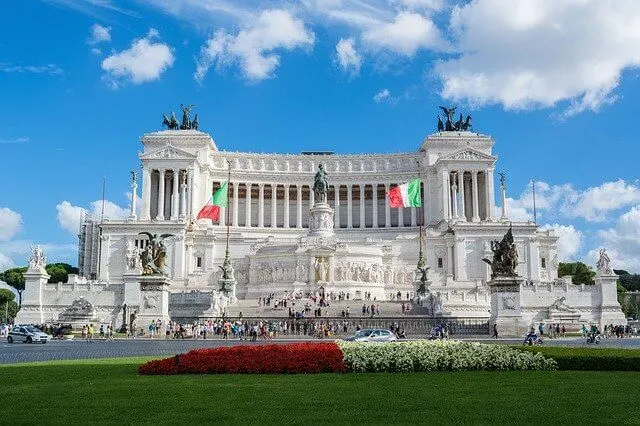
The Victor Emmanuel II National Monument (also known as Vittoriano or Altare della Patria / Altar of the Fatherland), is a national monument built in honour of Victor Emmanuel II, the first king of a unified Italy, located in Rome, Italy. It occupies a site between the Piazza Venezia and the Capitoline Hill.
An imposing building, it has since 1921, be the location of the tomb of the unknown soldier, a place in which the eternal flame shines and which is always guarded by two soldiers. Riding the elevator to its panoramic terrace also gives visitors one of the most stunning views of Rome.
Day Trips from Rome
Amalfi Coast
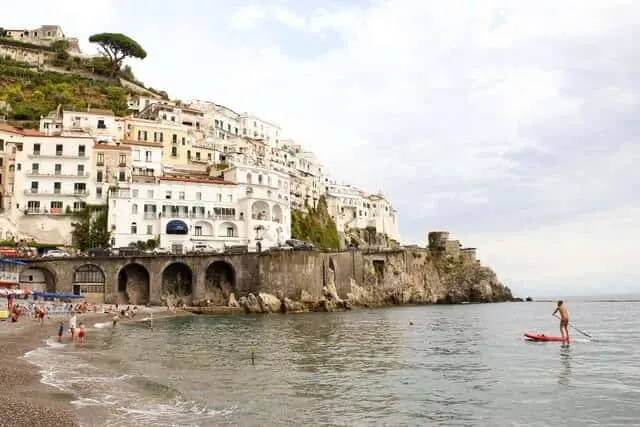
For those who are short on time but can’t miss the incredible hillside villages of the Amalfi Coast, this full-day tour from Rome takes visitors on the high-speed train to Naples before helping them explore the resorts of Amalfi & Positano via a comfortable coach. For those with more time on their hands or wishing to extend their Rome trip, we recommend spending around 4-5 days exploring the Amalfi Coast.
Florence (and Pisa!)
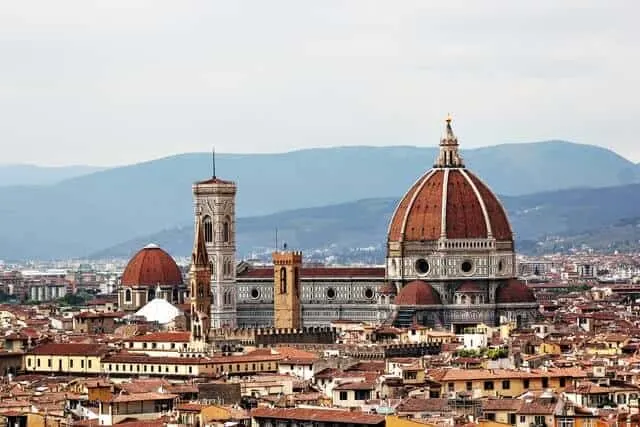
Florence is located 300 km north of Rome, however, the Italian train system makes visiting it on a day trip from Rome an absolute breeze (with the express trains taking as little as 1.5hours). Once there be sure to gaze upon the Duomo di Firenze, visit the famous statue of David in the Galleria dell’Accademia museum, and stop by the famous Ponte Vecchio Bridge.
And for those wanting to add a little more to their day trip from Rome, the iconic Tower of Pisa is only an hour away from Florence by train.
Book this smallgroup tour of Florence from Rome and be guided around the best sights of this beautiful city; or plan your own twin city break to Florence and Pisa.
Pompeii
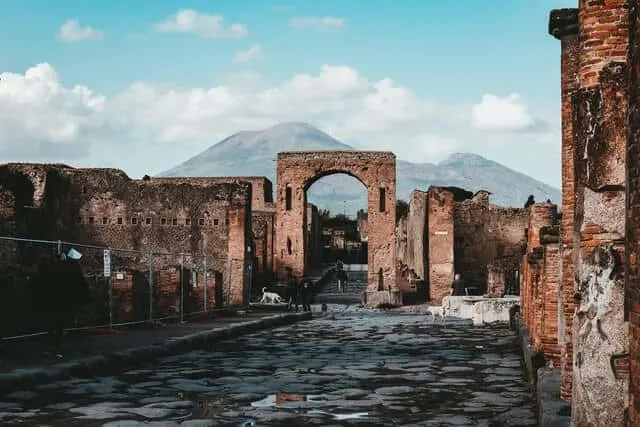
Pompeii, the ancient Roman city is one of the most popular day trips from Rome. In AD 79, Pompeii was buried under 4–6 meters of volcanic ash during the eruption of Mount Vesuvius, which destroyed the whole city and killed around 2000 of its inhabitants. Today visitors can walk around the ancient Roman city and see the remnants of buildings (and even their inhabitants). It’s a must for anyone who is interested in history and archaeological sites.
An independent day trip from Rome to Pompeii can easily be achieved by train. Catch the train from Roma Termini to Napoli Centrale, walk for about one minute to Napoli Piazza Garibaldi, and catch the train to Pompeii (towards Salerno). All up, the journey takes around 2 hours. And if you don’t feel confident, there are plenty of guided tours which provide transport, skip the line entry and a history lesson rolled into one!
We hope this guide to 15 Best Things to do in Rome Italy (perfect for first-timers) had been a huge help planning your Rome trip, and has shown you all the best things to see in Rome while you are there!
If you know of anyone else that needs a little bit of inspiration or assistance in planning their Rome vacation (or how to explore Rome while they are there!), please be sure to share this post on social media: Facebook, Flipboard, Twitter or grab one of the images from below for Pinterest. And remember – sharing is charing (and we thank you in advance!)
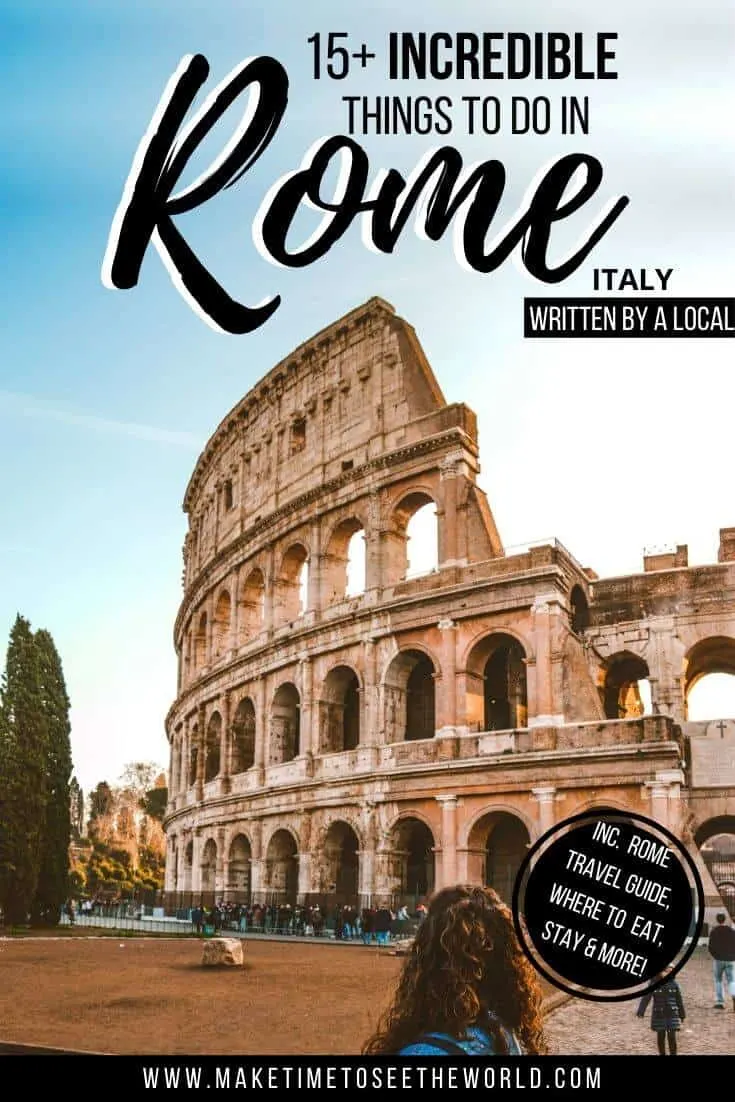

READY MORE EUROPE TRAVEL INSPIRATION? YOU MIGHT BE INTERESTED IN THESE TRAVEL TIPS, TRAVEL HACKS, TRAVEL ARTICLES, DESTINATION GUIDES, TRAVELER RESOURCES AND RELATED POSTS ABOUT OTHER AMAZING CITIES IN EUROPE:
- Italy: A Perfect weekend in Venice and How to Great Around Europe by Train
- Quotes & Wordplay: Adventure Quotes – Travel Quotes – Mountain Quotes – Beach Quotes – Ocean Quotes – Inspirational Disney Quotes & Unusual Travel Words with Beautiful Meanings.
- How to Pack your Carry On Like A Pro, including the Best Solid Toiletries for Travel – full of travel tips to make the most of those pesky weight and space restrictions!
- Adventure Travel: Road Trips Resources: Road Trip Packing List, Road Trip Tips & the ultimate Road Trip Playlist
- Stylish and Affordable Travel Gear – The Best Carry on Luggage for Frequent Travelers, The Best Hardside Luggage for you road warriors + The Best Passport Wallets to protect your most valuable travel possession!
Hi There! Thanks for reading our guide to the most 15+ BEST Things to see in Rome Italy (Perfect for first-time visitors) I just wanted to let you know that this post contains affiliate links, which means if you purchase something after clicking a link, I may get a small commission – which is at absolutely no cost to you. If you enjoyed this article and are going to be searching for some of the things I mention anyway, I would love it if you could click through from the links above & thank you in advance! Read my full Disclosure here.
And a huge Thank You for reading the MakeTimeToSeeTheWorld travel blog.
